A partnership does not pay tax on its own income but instead “passes through” any profits or losses to its partners on a Schedule K-1. Deciding whether to operate as a partnership or an S corporation, and subsequently filing Form 1065 or Form 1120S, requires careful consideration of tax implications, http://www.nomaaward.org/what-is-the-forensic-pathologist-pay-range-business.php business goals, and operational structures. Among the myriad of forms, Form 1065 and Form 1120S stand out for entities structured as partnerships and S corporations, respectively. An LLC that elects to be taxed as a C corporation would file Form 1120 and pay corporate income taxes on its profits.
Fill in Boxes A Through J
Also, you can save up to 19x compared to Paypal, and you won’t lose any money on hidden fees when paying your taxes. One of the biggest challenges with tax season is gathering all the necessary information and ensuring you’ve filled in the correct documentation. http://kub89.ru/kartinki-na-sait/kontent-dlya-saita/normativnye-akty Page 2 of the 1065 Form mostly has yes/no questions, and you may need to provide some additional information depending on how you answer some of the questions. After completing the first page, make sure to review the information and then sign and date.
How to avoid late filing penalties for 1065 and 1120S?
A contributes property X with an FMV of $100 and a tax basis of $60. The traditional method is used to allocate section 704(c) items pertaining to X. In the first year, the partnership has $10 of section 704(b) book depreciation, which is allocated equally to A and B for book purposes ($5 each). The partnership has no other income or deductions during the tax year. Under the traditional method, P allocates $1 to A and $5 to B for tax purposes. Assuming this is the only item where taxable income is affected by section 704(c) allocations during the current year, the partnership would report deductions of $1 for A and $5 for B in box 20, code AA, of Schedule K-1.
What IRS Form 1065 Reports
A partnership that is a section 721(c) partnership will also attach to its Form 1065 a Schedule K-1 for each partner that is a related foreign person with respect to the U.S. transferor. For an indirect partner that is a related foreign person with respect to the http://abcolyt.ru/padenie-evro-obankrotit-moldovu/ U.S. transferor, the Schedule K-1 will only include relevant information with respect to section 721(c) property. To be certified as a QOF, the partnership must file Form 1065 and attach Form 8996, even if the partnership had no income or expenses to report.
Mere co-ownership of property that is maintained and leased or rented isn’t a partnership. However, if the co-owners provide services to the tenants, a partnership exists. Line 15f, Other credits (code P), previously included a number of bulleted items. These items have been assigned individual codes for Schedule K, line 15, and box 15 of Schedule K-1. Other Credits , later, for the expanded list of codes and new energy credits.
Gather relevant financial documents and IRS forms
- Also, special rules apply to deductions for gifts, luxury water travel, and convention expenses.
- The IRS assesses a $220 late filing penalty per partner for each month or part of the month Form 1065 is delayed.
- Conversely, losses from the sale of assets are also factored in during the calculation.
- The IRS defines a “partnership” as any relationship existing between two or more persons who join to carry on a trade or business.

Vélemény, hozzászólás?